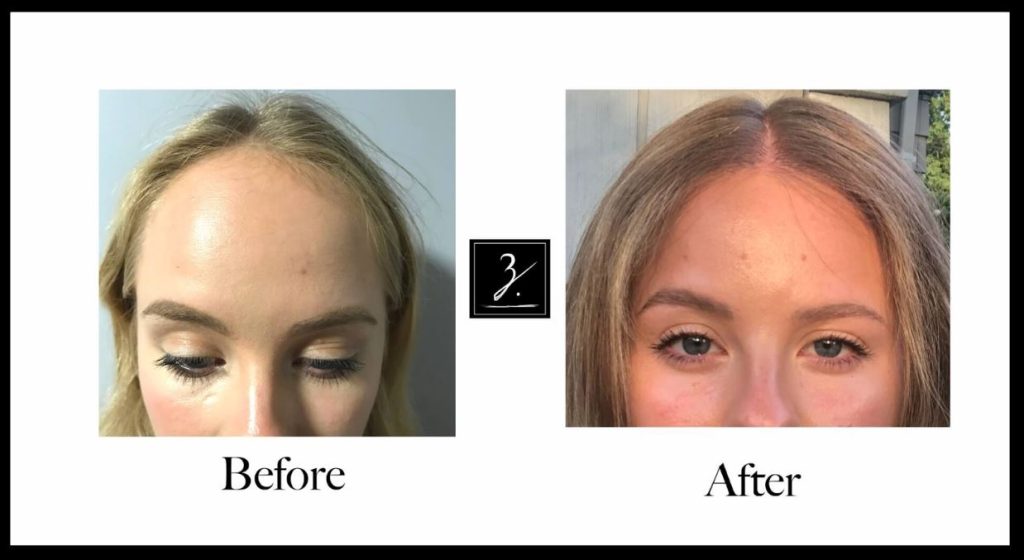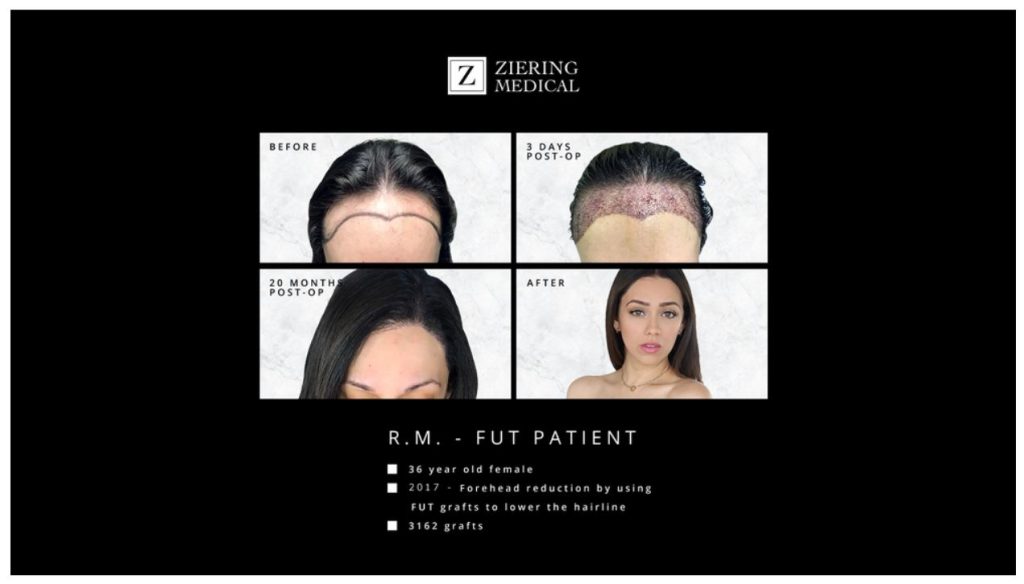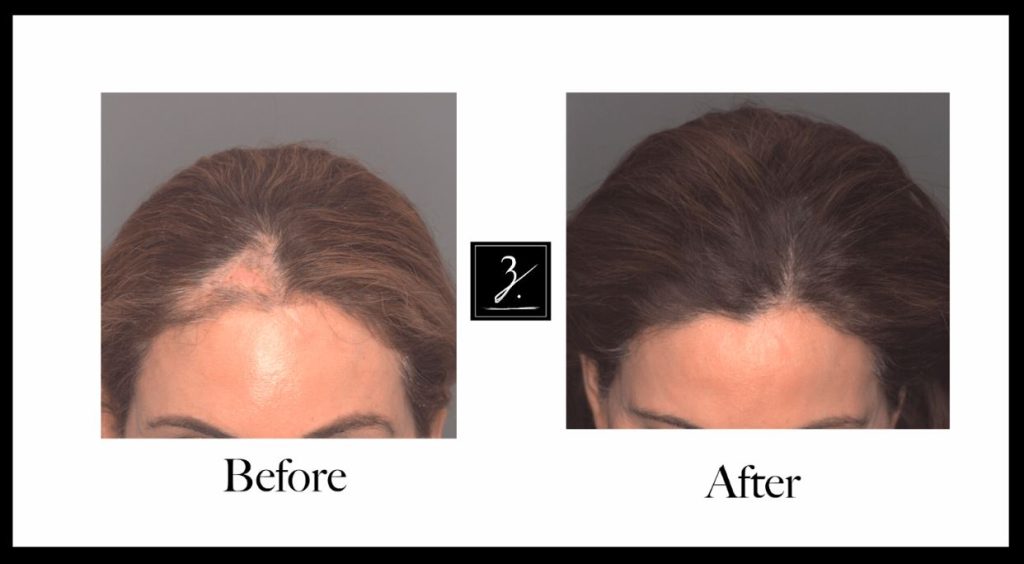Thinning Hair? Here Are 5 Best Hair Loss Treatments for Women

Up to 50% of women experience noticeable hair loss by age 50 and for many, it starts even earlier. The most common cause is female pattern hair loss, a progressive condition that leads to thinning at the crown and widening of the part line.
Ziering Medical offers a wide range of proven hair restoration services for women including topical treatments like ZMIN, Z-GRO Secretomes, and Z-factors, or laser hair therapy with the Z Cap, and advanced hair transplantation procedures which may be used as stand alone treatments but more likely are prescribed in personalized combinations to address your specific hair loss. In this article, we will explain why your hair is thinning, the best treatments for female hair loss, and what results you can expect.
The Most Common Cause of Hair Loss in Women
The leading cause of hair loss in women is androgenetic alopecia, also called female pattern hair loss. It’s genetic and progressive. Unlike male pattern baldness, it doesn’t cause complete baldness. Instead, it leads to diffuse hair thinning across the entire scalp and often a widening of the hair part line.
You might notice more scalp showing in photos or more hair left in your brush or shower drain. Unlike patchy hair loss, this type is diffuse. It spreads gradually across the top of the scalp. What’s happening beneath the surface is a slow, progressive miniaturization of the hair follicles. Due to a combination of genetics, hormones like DHT, and inflammation, the follicles begin to shrink and produce finer, shorter hairs with each growth cycle. Without early diagnosis and intervention, this process continues silently, often before visible thinning becomes apparent. Acting early is critical. Timely treatment can help slow shedding, preserve existing follicles, and even reactivate dormant ones.
Other Causes of Women’s Hair Loss
Not all hair loss is genetic. These are some of the most common non-hereditary causes behind hair thinning or shedding in women:
Hormonal Changes
Events like pregnancy, childbirth, menopause, and starting or stopping birth control can all cause significant hormonal shifts in the body, and your hair responds. Hormones like estrogen and progesterone play a vital role in supporting the hair growth cycle, helping keep strands in the growing (anagen) phase longer. When these hormone levels drop suddenly, it can push more hairs into the shedding (telogen) phase, leading to noticeable thinning. Additionally, conditions like Polycystic Ovary Syndrome (PCOS) can elevate androgen levels, such as testosterone, which the body can convert into DHT, a hormone known to shrink hair follicles and shorten the growth cycle. While hormones are essential for healthy, vibrant hair, imbalances can quietly disrupt the process, resulting in diffuse thinning or patterns similar to androgenetic alopecia.
Stress (Telogen Effluvium)
Physical or emotional stress, such as surgery, illness, or a traumatic event can shock the hair cycle, pushing a larger-than-normal number of hairs into the shedding (telogen) phase of the normal hair growth cycle. This often results in noticeable hair loss two to three months after the stressful event. Internally, chronic or extreme stress triggers a hormonal cascade, elevating cortisol levels while disrupting the balance of other key hormones like thyroid hormones, estrogen, and androgens. These shifts can impair blood flow to the scalp, increase inflammation, and interfere with the normal function of hair follicles, weakening hair growth, diminishing scalp health, and accelerating shedding. If you could actually see what stress is doing inside your body, you might be more motivated to redefine your lifestyle habits, manage stress more intentionally, and prioritize your overall health – not just for your hair, but your long-term well-being
Traction Alopecia
Tight ponytails, braids, hair extensions, or weaves can put repeated stress on the hair follicles, causing a condition known as traction alopecia. This constant pulling or tension causes inflammation around the follicle, weakening its anchoring structures and leading to thinning, breakage, and eventual follicle miniaturization. Over time, the sustained tension can scar the follicle and disrupt its ability to produce new hair altogether, resulting in permanent hair loss if the style is not changed. Early signs may include tenderness, redness, or small bumps along the hairline or scalp. Loosening hairstyles and giving the scalp time to recover can stop further damage and, in many cases, allow hair to regrow – especially if intervention happens before scarring sets in.
Thyroid Disorders
Both overactive (hyperthyroidism) and underactive (hypothyroidism) thyroid function can cause hair to become thin, dry, or brittle. Thyroid hormones help regulate the hair growth cycle, and imbalances often cause diffuse shedding across the scalp. A simple blood test is typically required to obtain an accurate diagnosis.
Nutrient Deficiencies
Hair relies on nutrients like iron, vitamin D, zinc, and B vitamins to grow. Iron deficiency is especially common in women and can mimic pattern hair loss. Crash diets, restrictive eating, or poor absorption can all lead to deficiencies that slow or stall hair growth.
A hair-friendly diet is rich in lean proteins like fish, eggs, poultry, and legumes, fresh leafy greens such as spinach and kale, colorful fruits and vegetables, nuts, seeds, and healthy fats like omega-3s from salmon or flaxseeds. This nutrient-dense approach closely resembles a Mediterranean-style diet, which emphasizes whole foods, anti-inflammatory ingredients, and a balanced intake of essential vitamins and minerals. If you suspect your hair loss may be linked to a deficiency, consult your physician for a blood test before starting supplements; targeted treatment is always more effective than guesswork.
Medications
Several medications list hair loss as a side effect. Common culprits include some antidepressants (SSRIs), blood pressure medications (beta blockers), acne drugs (like isotretinoin), and blood thinners. If hair loss starts after beginning a new medication, consult your doctor before stopping it.
Autoimmune Conditions (Alopecia Areata)
Alopecia areata causes patchy hair loss when the immune system attacks hair follicles. It can appear suddenly and may affect other areas like brows or lashes. It’s different from the gradual thinning of pattern hair loss and may respond to treatments like corticosteroid injections.
5 Best Hair Restoration Treatments for Women That Work
You don’t need a dozen products. You need the ones that work. Here are five female hair restoration treatments that consistently help our female patients regrow hair and improve density.
Minoxidil
Minoxidil is a clinically proven topical treatment for women’s hair loss. But at our practice, we take regular minoxidil to the next level. Our Formula ZMIN combines FDA‑approved minoxidil with retinoic acid and a blend of anti-inflammatory, antioxidant, and anti‑androgen ingredients.
It’s prescription-only and applied once or twice daily (20 drops), with early results appearing in about 6–8 weeks and fuller regrowth between 3–6 months. The addition of retinoic acid improves scalp delivery, while anti-inflammatory agents minimize irritation common with standard minoxidil formulations. Consistent use is key with managing and maintaining your hair regrowth with minoxidil. Once you stop applying or using this topical treatment, hair growth will cease and increased hair shedding will return.
Z-Factors
Z‑Factors is a non-invasive, in-office topical treatment with powerful nano-particles, including exosomes, growth factors, cytokines, peptides, and hyaluronic acid. Unlike PRP, this treatment doesn’t require blood draws or injections and causes minimal inflammation. It’s done professionally in-office to halt follicular miniaturization, boost hair shaft caliber, and improve scalp health, with gradual results over several months.
See how Z-Factors compares to PRP, especially if you’re looking for a less invasive option in this table.
| Treatment | PRP (Platelet-Rich Plasma) | Z-Factors |
| What it is | Concentrated platelets from your own blood | Lab-engineered growth factors, peptides, and exosomes |
| Delivery | Injections into the scalp | Topical, applied in-office (no needles) |
| Invasiveness | Minimally invasive (requires blood draw and injections) | Non-invasive (no blood draw, no injections) |
| Downtime | Mild redness, scalp soreness for 1–2 days | Minimal to none |
| Ideal for | Women with early to moderate hair loss | Women sensitive to injections or seeking no-downtime options |
| Frequency | Typically 3–4 sessions over 3 months, then maintenance | Series of sessions spaced over weeks or months |
| Benefits | Stimulates natural growth, improves thickness and density | Stimulates natural hair growth, supports scalp health, and halts miniaturization |
| Drawbacks | Some discomfort, cost, requires blood handling | Results may be gradual and require multiple sessions |
Low-Level Laser Therapy
Low-level laser therapy (LLLT) is a non-invasive treatment that uses red light to stimulate hair follicles and extend the growth phase of the hair cycle. It helps reduce shedding, improves hair density, and enhances the luster and shine of your hair over time. We offer laser hair therapy you can use at home with the Ziering LaserCap.
The Ziering LaserCap delivers clinical-strength laser therapy in a wearable, wireless device. With 304 medical-grade diodes, it’s FDA-cleared and designed for use at home for just 30 minutes per session, three times a week.
It’s portable, hands-free, and easy to use while working, commuting, or relaxing. Results typically start with reduced shedding in 6–8 weeks, with visible thickening in the months that follow. It’s often combined with other treatments like minoxidil, KeraFactor, or Z-Factors for enhanced results.
Hair Transplantation
Hair transplantation is typically considered when other treatments, like topicals or laser therapy, aren’t enough. It’s best suited for women with clearly defined thinning or areas of hair loss that haven’t responded to medical therapies. If you have stable donor hair available at the back and sides of the scalp and localized thinning at the crown, temples, or part line, you may be a good hair transplant candidate.
What’s the Best Hair Transplant for Women?
MDEE, also known as the strip FUT method, is the ideal hair transplant procedure for women. Unlike FUE, MDEE doesn’t require shaving the entire back of your head. Instead, it removes a thin strip of skin from the back of your head which is shaved short followed by recipient site creation by your Ziering Surgeon and the microscopic dissection of the follicular units for implantation. This means you can keep your hair long, and no one has to know you had surgery while you’re healing.
FUT also allows your surgeon to harvest more grafts in one session, which is especially important if you’re dealing with diffuse thinning and want fuller coverage. The linear scar is thin and easily hidden under your existing hair. For women who want density, discretion, and lasting results, FUT is usually the better choice.
Female Hair Transplant Before and After Photos

4662 Follicular Units, 2 MDEE/FUT Hairline Lowering Hair Transplant Procedures, Showing Pre-Op and 1 Year Post-Op Second Surgery

3,162 grafts, 1 MDEE/FUT Hairline Lowering Hair Transplant Procedure, Showing Pre-Op and 20 Months Post-Surgery

1712 Follicular Units, 1 MDEE/FUT Hair Transplant Procedure, Showing Pre-Op and 12 Months Post-Op
Get Expert Treatment for Female Hair Loss at Ziering Medical.
Restoring a female hairline requires precision, artistry, and a deep understanding of female facial structure. Women’s hairlines are softer, rounder, and more irregular than men’s. Getting it wrong can look obvious. Getting it right takes experience and artistry.
At Ziering Medical, female hair restoration is a specialty, not an afterthought. With over 100 million grafts transplanted and 75+ years of combined experience, our team delivers natural results women trust.
Call us or visit a Ziering Medical clinic near you to book a consultation. We serve patients all over the greater Tri-state area of New York, New Jersey, and Connecticut, as well as the greater Southern California area from Los Angeles and Beverly Hills to Newport Beach and San Diego. We also offer consultations for patients in and around Salt Lake City, Utah.
Frequently Asked Questions
How do I know if my hair loss is genetic or caused by something else?
A clinical evaluation and blood work can help rule out hormonal imbalances, thyroid issues, or nutritional deficiencies. If those are ruled out, you’re likely dealing with androgenetic alopecia or female pattern hair loss.
When should I see a hair restoration specialist?
If you’ve noticed progressive thinning for 3 months or more, or if treatments like minoxidil haven’t worked, it’s time to see a specialist. Early diagnosis and intervention impacts treatment outcomes.
Does hair transplantation work for women?
Yes. Women with localized thinning and stable donor hair are good candidates for a hair transplant. It’s ideal for those with hairline recession, traction alopecia, or crown thinning. Diffuse thinning may need medical treatment first. A specialist can confirm if surgery is the right option.
What’s the downtime for a hair transplant?
Most women return to normal activity within a few days. Early growth starts at 3–4 months, becoming more visible around 6-9 months, with full results being visible at 12–18 months.
Can I treat hair loss without surgery?
Yes. We offer several non surgical hair growth solutions like topicals, laser therapy, supplements, and in-office treatments like Z‑Factors and KeraLase, which may stimulate hair regrowth, improve hair health and density without surgery, especially if you start early. Many of these hair restoration treatments are used in combination based on your individual situation.
Will people know I had a hair transplant?
Not if it’s done right. With the right surgeon, technique, and artistry, the results can look so natural that no one will know you’ve had a hair transplant.
